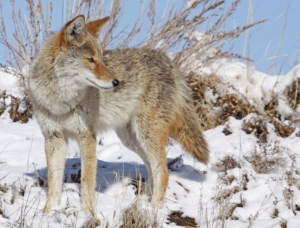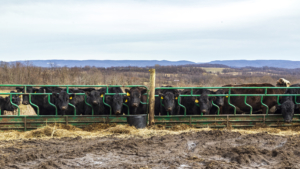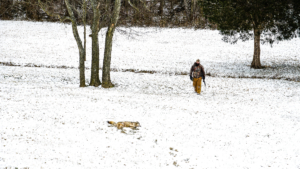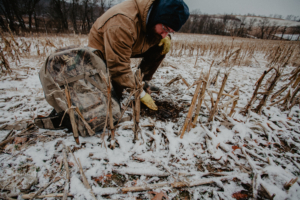Methods to Control Coyotes on Farms
Whether you own livestock on a farm or just like to hunt deer on your property, there are a few sounds you really don’t like to hear as evening approaches: coyote barks, yips, and howls. Hearing a lone coyote is troubling enough, but when you hear the whole choir chime in, you can’t help but feel nervous for your animals or the wild game animals you like to hunt. But if you have coyote problems on your land, what are you supposed to do about it? There are a few ways to control coyotes on farms, ranches, and recreational properties – some are more effective than others. But before you get out coyote hunting with a vengeance, there are a couple of things you should know.
The Effects of Coyotes on Other Animals
We’ve already discussed the various coyote effects on livestock in another article, so we won’t go into too much detail about that here. But suffice it to say that coyote attacks on livestock are consistently one of the biggest causes for predation deaths in sheep, goats, and cattle. Not to mention, coyotes are excellent predators of pets, such as cats and small dogs. They can be a real nuisance to farmers who just want to protect their animals and mind their own business, but don’t have the means to install high-quality fencing to keep predators out. That’s why so many landowners resort to looking for a way to control coyotes on farms or ranches with animals.
Similarly, a coyote population explosion on your land can be pretty devastating to wild game populations. While a lone coyote might get by on mice, squirrels, and scavenged dead animals, a small pack of coyotes will need to find more food for the pups. Packs will often target rabbits or larger animals (such as deer or antelope) or eat their fawns in the spring. If you’re a hunter or are leasing your land to hunters, you will probably get sick of it fast. It’s pretty common in some parts of the country for coyotes to beat hunters to the deer they shot, which means you arrive to a partially eaten carcass instead of a lot of venison.
How to Control Coyotes on Farms and Ranches
If you can identify with either of the perspectives above when it comes to coyotes on your property, you’re probably wondering how to get started. Here are a few common ways to control coyotes on farms – decide which might be best for your situation.
[av_promobox button=’yes’ label=’Coyote Effects On Livestock’ link=’manually,https://huntingleases.basecampleasing.com/coyote-effects-on-livestock-sheep-goats-cattle-management/ ‘ link_target=’_blank’ color=’theme-color’ custom_bg=’#444444′ custom_font=’#ffffff’ size=’large’ label_display=” icon_select=’no’ icon=’ue800′ font=’entypo-fontello’ box_color=” box_custom_font=’#ffffff’ box_custom_bg=’#444444′ box_custom_border=’#333333′ av_uid=’av-24263n’ custom_class=” admin_preview_bg=”]

Hunting Coyotes
The most popular (and some would say fun) way of removing coyotes is hunting, especially if thermal predator hunting is legal where you live. If you’re already a hunter or you want to offer a new and different kind of hunting opportunity to your lessees, hunting coyotes is a great way to extend the hunting season. In many cases, the coyote hunting season is outside of the normal hunting season for game animals, and you may be able to use night vision/thermal imaging scopes to hunt them, which is nothing short of thrilling. You can set a blind up where you have a good vantage point on your farm or property (with the wind in your face), and wait for coyotes to appear. You can also try using predator calls or decoys to fool a coyote into thinking a wounded rabbit or fawn is nearby. As for good coyote hunting rifles, a medium powered bolt-action rifle (.223 or .243 caliber) or AR both work well for predator hunting. You can get much faster follow-up shots with an AR versus a bolt-action though.
Trapping Coyotes
Undoubtedly, one of the most effective forms of coyote population control is trapping. But coyotes are smart animals, and they can quickly learn to avoid poorly-executed sets. So if you’re new to trapping, your rookie mistakes could educate the local pack and make it more difficult to control coyotes on farms in the future. That being said, foothold traps and neck snares are both used for trapping coyotes. If you catch a coyote in a foothold trap, check first to make sure it is securely held in the trap. Then slowly walk up to it and shoot it in the head with a small caliber rifle (a .22 LR works fine). Placing a snare in a small fence opening is a good place to catch coyotes skirting field edges.
Non-lethal Coyote Control
While killing predators to protect livestock has been a human response for as long as we’ve domesticated animals, recent research might make us pump the brakes a little. You’ve probably heard that killing coyotes makes more coyotes, and in a loose sense, that’s true. When there are fewer individuals in a given area, there is generally more food available. That means adults coyotes will generally be healthier and they respond by having larger litters. The other reason killing coyotes doesn’t work sometimes is because when a coyote that maintains a certain territory disappears, others will move into that area to claim it, especially in areas with a high coyote population. If the newcomer is aggressive and has a tendency to kill livestock, you may have just made the problem worse. As a result, many people resort to non-lethal deterrence measures to control coyotes on farms. These might include better electric fencing or corrals; using guard dogs, donkeys, or llamas; or light and noise repellants.
Property Size Considerations
Now you have a few options to control coyotes on your farm, but does that mean hunting coyotes is appropriate for your property? Not necessarily. For example, smaller properties (40 acres and under) may have a tougher time controlling them because coyotes spend less time on your specific property. They may come onto it to cause some damage to your livestock or the local deer herd, but it is tougher to catch them while on your land. Whereas, large ranches (hundreds or thousands of acres) could be supporting whole packs of coyotes. In this sense, it may be easier to initiate a proper coyote control program (including hunting, trapping, and avoidance measures) on larger properties. But as mentioned earlier, offering coyote hunts on your lease could be a nice bonus hunt for lessees who are financially invested in keeping the deer and turkey population thriving.
As you can see, the effects of control on coyote populations are tough to nail down. On one hand, hunting them can have an immediate effect of removing predator pressure on your livestock. But on the other hand, you could be opening a can of worms when you kill a single coyote. It all comes down to what you want to do and how you want to run your property. If the idea of coyote hunting excites you, then by all means, do it! But if your property is small or you don’t want to risk it, you could try some alternative, non-lethal options to see how effective they are in your situation.
Leasing the Hunting Rights on Farmland and Pastures
Making a living off the land is not for everyone. But understanding how to utilize the resources wisely to generate a payday is a big part of a landowner’s success. Every farmer has a plan to generate revenue for the year from row crops to timber harvests to CRP, making sure that you are sustainably working the land is critical. Leasing your property is a noninvasive way to generate revenue from your farm ground, while also providing protection against trespassing and controlling detrimental wildlife populations that could be causing significant crop damage. By reaching out to Base Camp Leasing and its team of land appraisal experts, you will be earning supplemental income from your property in no time, while protecting your land from unwanted people and animals.





Leave A Comment